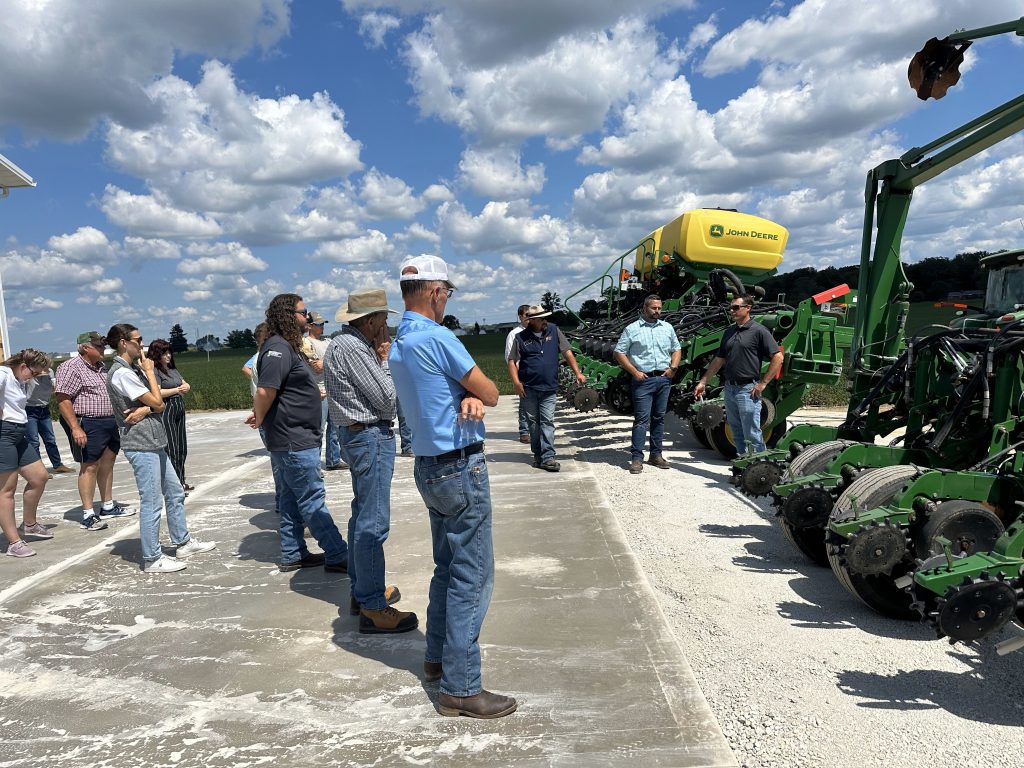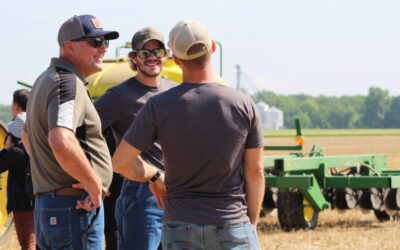Lower costs, less compaction and increased yields after adopting conservation practices

By Amie Simpson
Joe Hamilton, a farmer near Muncie, Ind., has seen a positive impact on his operation since planting cover crops and using no-till practices. Hamilton returned to his family farm in 2015 after a decade of working as a mechanical engineer. By 2018, his operation was 100 percent no-till, and within a few years of that he was planting cover crops on 100 percent of his acres.
Since then, the corn and soybean farmer has lowered costs by reducing herbicide use as well as fertilizer application. He switched to addressing phosphorus needs with poultry litter and has found success with variable rate applications when needed based on soil testing.
Hamilton noted that progress takes time. Cover crops are a long-term investment in soil health as it can take about three years of annual use to see those improvements in organic matter and yield.
“I have seen gradual yield increases every year since that initial adoption period,” he said. “I’m also seeing better water infiltration when we get heavy rains. Less of the water pools on the surface and more of it makes its way into the soil. I’m seeing less compaction, especially in wheel tracks, and less crop variability within fields. I continue to see all of these things, and it’s getting better every year.”
Hamilton advises farmers to assess their capabilities prior to implementing cover crops or other similar practices. “Before you jump in and plant all your acres to cover crops and say that you’re going to go no-till, you need to have a termination plan in place for your cover crops,” he said.
Questions to think about include: What are you going to do if you have overwintering cover crops? Are you going to terminate those with herbicide two weeks before you plant? If so, are you going to do your own spraying or are you going to rely on someone else to do it?
Start small, stay patient
Hamilton encourages farmers to start small and give it the time necessary to be successful.
“It took three years before I really saw my yields increasing,” he explained. “I don’t want to see farmers try it for a year or two and then give up quickly when the cost share goes away or when they decide they’re not seeing the yield increase as they expected.”

Hamilton also suggests that farmers utilize available programs. He has participated in the Natural Resources Conservation Service (NRCS) Environmental Quality Incentives Program (EQIP), as well as the Conservation Stewardship Program (CSP).
“Through those experiences, I created a nutrient management program and met my agronomist,” he said. “He helped me with balancing my soil, applying high calcium lime and gypsum, and making adjustments to get to a place where the soil is healthier. That’s been a big part of the farm’s transition.”
He participated in the Indiana Soybean Alliance and Indiana Corn Marketing Council Upper White Cover Crop Program. He shared his experiences with implementing conservation practices and participating in the program during an Upper White Cover Crop Field Day he hosted on his farm in August.
Other advice he has is to find an independent agronomist, talk with farmers who are using these practices, and attend relevant events. Hamilton has found success attending the National No-Till Conference. He says it provides an opportunity to network with other farmers and hear what has and hasn’t worked on their operations.
The next National No-Till Conference will take place Jan. 7-10 in Louisville, Ky.
Looking back, looking forward
Hamilton has had the opportunity to reflect on returning to his family farm. He knew he may not have another chance to become more involved in the operation and that wasn’t a risk he was willing to take.
“The way that I saw it was, if I came back in 2015 and tried to take over the farm and I couldn’t make it work, I could always go back and become an engineer again,” he said. “If I didn’t come back and the farming operation shrank in size, it was going to be difficult for me to ever try that again. That was nine years ago and I’m still doing it.”
Hamilton noted that it hasn’t always been easy with lots of hours, money and stress surrounding fluctuating prices and conditions.
“I planned my return based on 2013 prices, so when I looked at what income I was making, what I thought I would need to live here and support my family, 2013 prices were rather good. By 2015, when I quit my job, prices had gone down, so right off the bat it was challenging,” he said. “Since then, prices have continued to go up and down, but reducing our variable costs through no-till, for example, has helped us withstand those fluctuations.”
The operation got its start with Hamilton’s grandfather in the early 1950s. When his father took over in the 1970s, he grew it into a conventional row-crop operation with tillage and corn and soybean rotations. When Hamilton returned to the operation in 2015, he knew he wanted to implement some different practices to improve nutrient management and increase profitability.
“When I came back, the farm was much like it was when I left. We used a lot of fuel and labor and had a lot of older equipment that got the job done painfully,” Hamilton explained. “I saw that as unsustainable from a labor, farm economic and environmental standpoint. I wanted to set the farm up to be successful in the coming decades, and I decided that we had to make changes – like implementing no-till and planting cover crops – to do that.”
He added that the challenges have been worth it, and he continues to implement practices to reduce costs of production, increase profitability, and improve the soil health of the farm for future generations.
Posted: November 16, 2024
Category: ICMC, Indiana Corn and Soybean Post - November 2024, ISA, Sustainability



